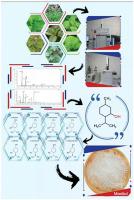Industrial Crops and Products ( IF 5.6 ) Pub Date : 2021-09-13 , DOI: 10.1016/j.indcrop.2021.114039 Seyed Ali Moetamedipoor 1 , Mohammad Jamal Saharkhiz 1 , Ahmad Reza Khosravi 2 , Abolfazl Jowkar 1

|
Mentha is an important aromatic plant in the Lamiaceae family with a great industrial potential which has a very complex classification. Mint genotypes (Mentha × piperita ‘Black’, M. × piperita ‘White’, M. × aquatica, M. × villosa, M. longifolia, M. rutoundifolia, M. suaveolens) were gathered from different regions of Iran to investigate their essential oil (EO) yield and components. Mints were cultivated in the greenhouse and their essential oils were obtained by hydro distillation. EO yield varied from 0.51 to 1.3% (w / w). Gas chromatography analysis revealed that each species consisted of 46–64 constituents which make up about 98.2 %–99.85 % of their essential oils. A total 111 types of chemicals were identified, of which only ten were common between species, which together constitute 0.5 %–3.5 % of the total essential oils. The other 101 components showed a great diversity, of which 29 were major constituents of these genotypes. Principle component analysis (PCA) showed that the type and amount of the constituents are important to determine their groups. Diversity classification based on quantity and quality of EOs, put them into four groups. The highest detected components in the respective mints were: carvone (55.08 %), M. suaveolens; menthol (53.1 %), M. ×piperita ‘Black’; pulegone (44.55 %), M. longifolia; menthofuran (38.67 %), M.×aquatica; menthol (32.36 %), M. × piperita L. ‘White’; carvone (27.12 %), M. rutoundifolia; and neo-menthol (22.79 %), M.× villosa. For the first time new constituents were identified: α-terpinyl acetate (5.03 %) and geranyl tiglate (10.81 %) were found in M. longifolia; carvone (27.12 %) was identified in M. rutoundifolia; and neo-menthol (22.79 %) and pulegone (10.90 %) were detected in M. villosa. The phytochemicals demonstrate a great diversity among the studied Iranian mint species. These results merit further investigations at the gene expression and proteomics levels.
中文翻译:

伊朗薄荷的精油化学多样性
薄荷是唇形科重要的芳香植物,具有巨大的工业潜力,分类非常复杂。薄荷基因型(Mentha × piperita 'Black', M. × piperita 'White', M. × Aquatica , M. × villosa , M. longifolia , M. rutoundifolia , M. suaveolens) 来自伊朗不同地区,以调查其精油 (EO) 产量和成分。薄荷是在温室中种植的,它们的精油是通过水力蒸馏获得的。EO 产率从 0.51% 到 1.3% (w/w) 不等。气相色谱分析表明,每个物种由 46–64 种成分组成,约占其精油的 98.2%–99.85%。共鉴定出 111 种化学物质,其中只有 10 种是种间共有的,它们总共占精油总量的 0.5%–3.5%。其他 101 种成分显示出很大的多样性,其中 29 种是这些基因型的主要成分。主成分分析 (PCA) 表明,成分的类型和数量对于确定它们的组很重要。基于 EO 数量和质量的多样性分类,把它们分成四组。各个薄荷糖中检测到的最高成分是:香芹酮 (55.08 %)、M. suaveolens ; 薄荷醇 (53.1 %), M. ×piperita 'Black'; pulegone (44.55 %), M. longifolia ; 薄荷脑 (38.67 %), M.×aquatica ; 薄荷醇 (32.36 %),M. × piperita L. 'White';香芹酮 (27.12 %), M. rutoundifolia ; 和新薄荷醇 (22.79 %),M.× villosa。首次确定了新成分:在长叶香叶中发现了醋酸α-松油酯(5.03%)和香叶酯(10.81%);在M. rutoundifolia中鉴定出香芹酮 (27.12 %) ;在M. villosa中检测到新薄荷醇 (22.79 %) 和胡薄荷酮 (10.90 %). 植物化学物质在所研究的伊朗薄荷物种中表现出很大的多样性。这些结果值得在基因表达和蛋白质组学水平上进一步研究。











































 京公网安备 11010802027423号
京公网安备 11010802027423号